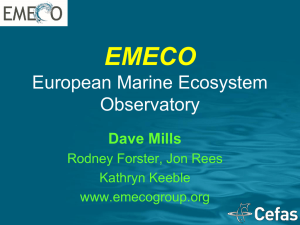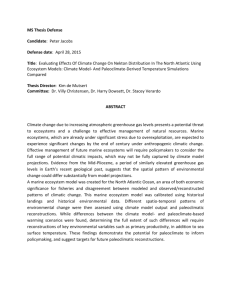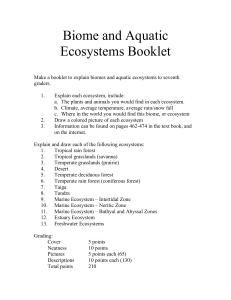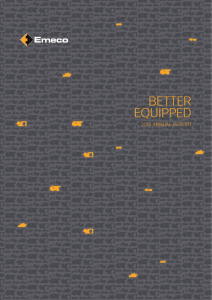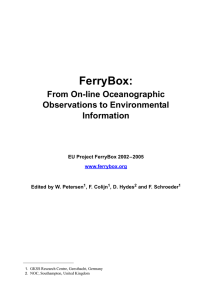European Marine Ecosystem Observatory
advertisement
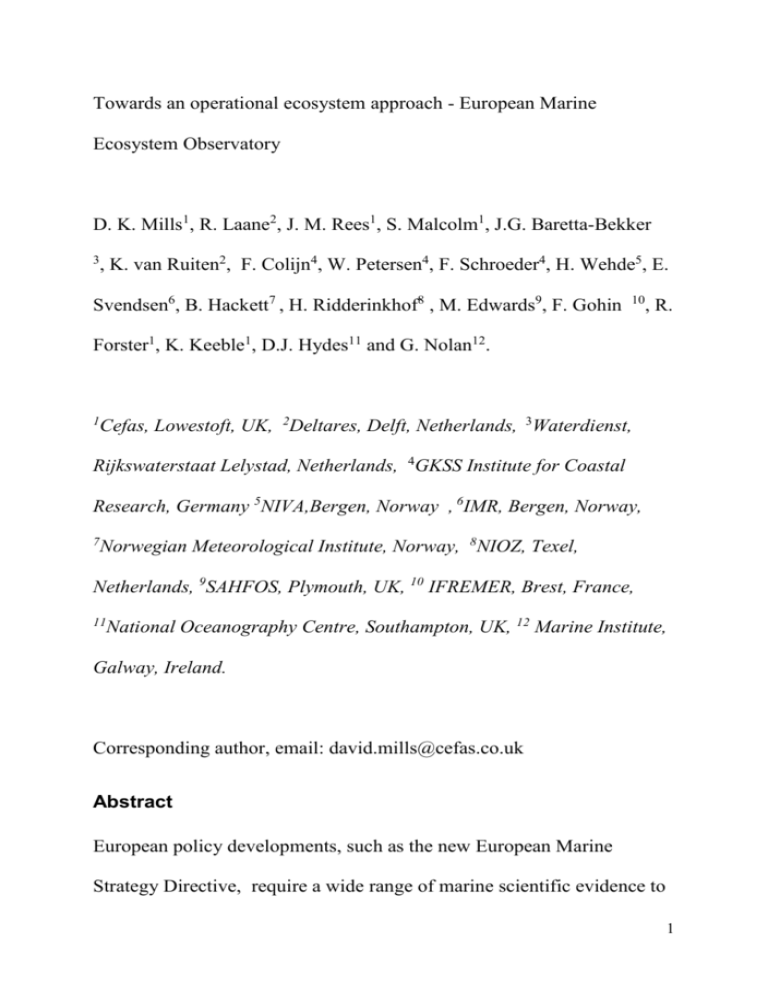
Towards an operational ecosystem approach - European Marine Ecosystem Observatory D. K. Mills1, R. Laane2, J. M. Rees1, S. Malcolm1, J.G. Baretta-Bekker 3 , K. van Ruiten2, F. Colijn4, W. Petersen4, F. Schroeder4, H. Wehde5, E. Svendsen6, B. Hackett7 , H. Ridderinkhof8 , M. Edwards9, F. Gohin 10 , R. Forster1, K. Keeble1, D.J. Hydes11 and G. Nolan12. 1 Cefas, Lowestoft, UK, 2Deltares, Delft, Netherlands, 3Waterdienst, Rijkswaterstaat Lelystad, Netherlands, 4GKSS Institute for Coastal Research, Germany 5NIVA,Bergen, Norway , 6IMR, Bergen, Norway, 7 Norwegian Meteorological Institute, Norway, 8NIOZ, Texel, Netherlands, 9SAHFOS, Plymouth, UK, 10 IFREMER, Brest, France, 11 National Oceanography Centre, Southampton, UK, 12 Marine Institute, Galway, Ireland. Corresponding author, email: david.mills@cefas.co.uk Abstract European policy developments, such as the new European Marine Strategy Directive, require a wide range of marine scientific evidence to 1 support the ecosystem-based approach to the management of human activities. The evidence required will be within 'regions' which cross national boundaries and be based on observation from physics to fish over wide time and space scales. As a step towards demonstrating this new approach, a European Marine Ecosystem Observatory (EMECO) has been established that initially focuses on observations in the North Sea. The aim of EMECO is to serve as a network linking European research and monitoring communities with complementary interests focussed on innovative monitoring methods and strategies, that integrate modelling, field measurements and remote sensing. EMECO builds on existing international cooperation including on-going research and monitoring projects as well as current networks (e.g. EuroGOOS, NOOS, ECOOP, GMES). Methods for integrating and interpreting spatial and temporal multinational data sets are under development and a prototype application using Google Earth has been implemented allowing users to manipulate data and visualise integrated information products. EMECO is addressing an urgent need for integrated international initiatives that are essential in supporting sustainable development. 2 1. Introduction EMECO (European Marine Ecosystem Observatory; www.emecogroup.org) was formed in response to new challenges posed by the new European Marine Strategy Framework Directive (MSFD) and the implicit need to deliver an ecosystem approach. The aim of EMECO is to serve as a network linking European research and monitoring communities with complementary interests focussed on innovative monitoring methods and strategies, that integrate modelling, field measurements and remote sensing. EMECO builds on existing international cooperation including on-going research and monitoring projects as well as current networks (e.g. EuroGOOS, NOOS, ECOOP, GMES). The consortium partners include agencies and institutions with responsibilities for monitoring and assessment of environmental status and also for improving understanding through research in European shelf-seas. 3 The Ecosystem Approach is, regarded by Rice et al. (2008), as a comprehensive integrated management of Figure 1. Map showing the location of a range of monitoring programmes undertaken by EMECO partners in the North Sea in the last five years. These include Ferrybox routes operated by GKSS (Germany) and NIVA (Norway), CPR operated by SAHFOS (UK), a wave monitoring network (WaveNet) and SmartBuoy locations operated by Cefas (UK) and at the Oyster Grounds in jointly with the Netherlands Rijkswaterstaat (RWS) and survey vessel observations. human activities based on the best available scientific knowledge about the ecosystem and its dynamics. The desired outcome is to identify and take action on influences which are critical to the health of the marine ecosystems, thereby achieving sustainable use of ecosystem goods and services and maintenance of ecosystem integrity.’ Delivery and application of an ecosystem approach requires monitoring and assessment based on sound science for identifying ecological objectives, identifying indicators and determining reference points. Against a background of increasing demand for resources there is a need 4 for cost effective use of existing monitoring programmes and implementation of new approaches that will add further value to these programmes. There is an urgent need to maximise synergy between current national monitoring programmes that will begin to provide the required comprehensive spatial coverage of the entire North Sea system. Implementation of new approaches that integrate low and high frequency spatial and temporal data from multiple platforms (e.g. buoys, landers, ships of opportunity, satellites) together with data from models are the key to this strategy. 2. Approach To meet these requirements EMECO is adopting an integrated approach that combines monitoring, modelling and research to improve our knowledge of the current status of shelf seas. In turn, this provides the background knowledge needed to make reliable predictions of future environmental and trophic status. It builds on an existing pan-European observational infrastructure that is multi-scale and multi-disciplinary. 5 Table 1. The range of platforms, data return type and variables measured by the EMECO partners in the North Sea (SOOP, Ship of Opportunity; RV, Research Vessel). NRT is near real-time data return Biological Chemical Phytopl. + + + + + + + + + + + + + + + + Fish Oxygen + Zoopl. Nutrients NIOZ NIVA + + + + + SmartBuoy NRT + WaveNet Waverider buoy Marcoast products NRT + R.V. Marcoast products FerryBox Ferrybox Light BSH MUMM Physical IFREMER Waves Cefas SPM R.V R.V. SOOP – CPR R.V. Salinity RWS IMR SAHFOS NRT Temp. Ferrybox Data return Platform Group GKSS + + + + + + + NRT + + + + + + + + + + + + + + + NRT NRT NRT + + + + + The wider North Sea provides a number of opportunities for synergy between on-going national monitoring and research programmes operated by EMECO partners (Figure 1). For example, a Cefas SmartBuoy is deployed on the Dutch Oyster Grounds in collaboration with the Dutch Rijkswaterstaat and Deltares. This region is also in the 6 vicinity of a joint Continuous Plankton Recorder (CPR) route (HE) and a GKSS Ferrybox route between Immingham and Cuxhaven as well as over flights by satellites that provide images of water quality parameters derived from ocean colour. A similar complementary approach is seen in the UK’s NOC (see www.noc.soton.ac.uk/ops/Ferrybox_index.php) Ferrybox between Portsmouth and Bilbao that also tows a CPR. In this example Ferrybox provide information on environmental control variables that improves understanding of the CPR observations on the abundance and distribution of plankton. These examples illustrate the synergies achieved through the EMECO initiative. By bringing together high-frequency fixed point observations with repeated spatial observations from Ferrybox and survey vessels coupled with satellite observations we are able to resolve spatial variability at regional scales. These programmes include physical, chemical and biological measurements (Table 1) from plankton up to fish. In addition, a number of the EMECO partners run complex coupled hydrodynamic models with North Sea domains that benefit from these observations and in return provide tools for improving understanding and 7 predicting changes in the ecosystem in this region. A focal point for EMECO will be to provide mechanisms not only for coordinating ongoing observations but also to identify methods for bringing together multi-agency data from a range of sampling platforms with model results. This will generate integrated products for use in environmental assessments and also for research. For example, under the auspices of OSPAR a number of these models, were used to predict the future eutrophication status of the North Sea as a result of OSPAR recommended riverine nutrient reductions (see: www.cefas.co.uk/eutmod). The models were calibrated and validated with integrated datasets derived from research (NERC North Sea Programme) and national marine monitoring programmes. This work revealed that data availability for calibration and validation as well as forcing (e.g. riverine nutrient inputs) for the North Sea is very patchy, not easily available. This limits our ability to calibrate and validate these numerical models. Nevertheless, by drawing together multi-national monitoring and research data and multiple model results it was possible to predict, together with estimates of uncertainty, the eutrophication status of the North Sea for a range of nutrient reduction scenarios. This work is essential for OSPAR in determining the effectiveness of current 8 ‘nutrient reduction’ strategies for elimination eutrophication and developing future strategies (OSPAR, 2008). This work exemplifies the benefits of the ‘integrated approach’ central to the concept of EMECO. In Norway an integrated approach has also been adopted using an operational “ecosystem” model (http://wms.met.no/moncoze/ ) together with data from satellite and in situ observations has been used to predict the distribution, development and decay of harmful algal blooms. The growing interest in EMECO reflects the benefits that accrue from adopting an integrated pan-European approach. Such benefits include improving the partners ability to contribute to robust assessments and provide improved advice to government agencies required to enable the competent authorities to meet their obligations to EU Directives and international conventions. For example, by increasing the availability of data for established indicators such as nutrient and chlorophyll concentrations then the evidence base on which environmental assessments are based will be strengthened. By bringing together the national agencies responsible for monitoring and assessment the improved dialogue can bring about a greater likelihood of achieving consensus in the international policy fora that agree outcomes to 9 assessments. The overall result is greater confidence in the outcome of formal assessments of environmental status that may in some cases be subject to legal scrutiny. However, the integration of temporally and spatially disparate multivariate data set that have both multi-agency and multinational sources and collected for different reasons is time intensive. It is also inefficient for each partner with a common need for integrated products to create them independently. To address this need, we have begun to develop an automated method that exploits the capability of Google Earth to manipulate and display geo-referenced data. 3. Data Integration and Assessment System A prototype application has been developed that allows users to integrate multi-platform (e.g. satellite, buoys, FerryBox), multi-agency and multinational data sets. The EMECO data integration and assessment system is a suite of web-based tools that enable rapid integration and visualisation of multi-parameter, multi-platform (e.g. satellite, buoys, FerryBox), multi-agency, and multinational data. In the first instance it has been designed is to deliver policy-relevant information products in a transparent and auditable manner that increase confidence in the outcome to formal environmental assessments at a regional scale. It has a fully 10 interactive user interface that allows users to select date, output type, averaging period, regions and areas, and platforms and parameters of interest. Users can select data output in the form of XML (Data), KML (Google Earth Maps), CSV (Data), Assessment Maps and time series plots. Data sources for the North Sea currently include national marine monitoring data (as submitted to ICES), Cefas SmartBuoy and Wavenet data sets and satellite derived chlorophyll and temperature. 4. Applications The data integration and assessment system has been designed to facilitate more efficient environmental assessments by allowing manipulation of the data into a form amenable to environmental assessments. There is an initial focus on assessment of eutrophication through the application of the OSPAR Comprehensive Procedure (CP). The CP has a clearly defined procedure that requires calculation of the value of a series of linked environmental indicators. The assessment maps in particular are designed to support the application of the CP by mapping the levels of indicators (e.g. chlorophyll and nutrient concentration) together with levels of confidence onto OSPAR defined 11 water bodies in the North Sea. However, the EMECO data tools support a range of potential uses where regional scale integrated data sets are required. 5. Summary and conclusions EMECO is a network of European research and monitoring groups with complementary interests focussed on innovative monitoring methods and strategies that integrate modelling, in situ field measurements and remote sensing. EMECO is a timely initiative that builds on existing international cooperation including on-going research and monitoring projects as well as current networks (e.g. EuroGOOS, NOOS, ECOOP, GMES). Integration is a key element of the EMECO initiative where new information products are derived through optimal combinations of observed data from multiple sources and model results. To encourage access and uptake web-based tools are being developed to allow users to visualise and generate new information products in support of environmental assessments and research needs. Whilst the initial focus is on the North Sea the intention is to extend the domain to include the 12 Celtic Seas to the west of the UK within a Western Shelf Observatory and to draw in new partners as appropriate. References Rice, J. Trujillo, V., Jennings, S., Hylland, K., Astudillo, A. and J.N. Jensen (2008). Guidance on the Application of the Ecosystem Approach to Management of Human Activities in the European Marine Environment. ICES Cooperative Research Report, Rapport de Recherches Collectives, 273, 28pp. OSPAR Commission, 2008. Nutrient reduction scenarios for the North Sea - Environmental consequences for problem areas with regard to eutrophication following nutrient reductions in model scenarios (55 pp). Mills, D.K., Baretta-Bekker, H and H. Lenhart. ISBN 978-1906840-15-0. Publication Number: 374/2008 13
